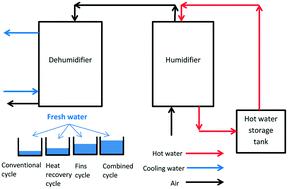当前位置:
X-MOL 学术
›
Environ. Sci.: Water Res. Technol.
›
论文详情
Our official English website, www.x-mol.net, welcomes your
feedback! (Note: you will need to create a separate account there.)
Performance enhancement of a humidification–dehumidification seawater desalination system
Environmental Science: Water Research & Technology ( IF 3.5 ) Pub Date : 2020-09-25 , DOI: 10.1039/d0ew00558d Hamed Abbady 1, 2, 3, 4, 5 , A. S. A. Mohamed 1, 2, 3, 4, 5 , M. Salem Ahmed 1, 2, 3, 4, 5 , Hamdy Hassan 5, 6, 7, 8, 9
Environmental Science: Water Research & Technology ( IF 3.5 ) Pub Date : 2020-09-25 , DOI: 10.1039/d0ew00558d Hamed Abbady 1, 2, 3, 4, 5 , A. S. A. Mohamed 1, 2, 3, 4, 5 , M. Salem Ahmed 1, 2, 3, 4, 5 , Hamdy Hassan 5, 6, 7, 8, 9
Affiliation

|
Performance evaluation of a humidification–dehumidifcation desalination system using three modified cycles (heat recovery, fins, and heat recovery combined with fins) is investigated and discussed. In the heat recovery cycle, a portion of the hot condensing water in the dehumidifier replaces the water evaporated in the humidifier. In the fins cycle, the fins are fixed between the humidifier and dehumidifier to precool the hot air coming out of the humidifier in order to improve the system performance. The impact of various operating parameters such as water temperature, mass flow rate ratio, and cooling water flow rate on the productivity, gain output ratio, recovery ratio and exergetic efficiency is evaluated. The results indicate that increasing the mass flow rate ratio, water temperature, and cooling water flow rate increases significantly the productivity. Compared with the conventional cycle, at a water temperature of 50 °C, the fins cycle increases the productivity, gain output ratio, recovery ratio, and exergetic efficiency by an average of 18%, 12.3%, 13.7% and 15.9%, respectively. Further, the heat recovery cycle increases the gain output ratio and exergetic efficiency at a water temperature of 50 °C by an average of 2.5% and 7.5%, respectively, while it has no effect on the productivity and recovery ratio. The estimated cost of fresh water production for the conventional cycle, heat recovery cycle, fins cycle, and heat recovery combined with fins cycle is about 0.094 $ per L, 0.087 $ per L, 0.072 $ per L, and 0.066 $ per L, respectively.
中文翻译:

加湿-除湿海水淡化系统的性能增强
研究并讨论了使用三个改进的循环(热回收,散热片和热回收与散热片相结合)的加湿-除湿淡化系统的性能评估。在热回收循环中,除湿机中的一部分冷凝水会代替加湿器中蒸发的水。在散热片循环中,散热片固定在加湿器和除湿器之间,以预冷从加湿器出来的热空气,以提高系统性能。评估了各种操作参数(例如水温,质量流量比和冷却水流量)对生产率,增益输出比,回收率和能量效率的影响。结果表明,增加质量流量比,水温,冷却水流量大大提高了生产率。与常规循环相比,在50°C的水温下,鳍片循环的生产率,增益输出比,回收率和能量效率平均分别提高18%,12.3%,13.7%和15.9%。此外,在50℃的水温下,热回收循环将增益输出比和能量效率分别平均提高2.5%和7.5%,而对生产率和回收率没有影响。常规循环,热回收循环,散热片循环和热回收与散热片循环相结合的淡水生产成本估计分别约为每升0.094美元,每升0.087美元,每升0.072美元和每升0.066美元。 。鳍片周期分别将生产率,增益输出率,回收率和精力充沛的效率分别提高了18%,12.3%,13.7%和15.9%。此外,在50℃的水温下,热回收循环将增益输出比和能量效率分别平均提高2.5%和7.5%,而对生产率和回收率没有影响。常规循环,热回收循环,散热片循环和热回收与散热片循环相结合的淡水生产成本估计分别约为每升0.094美元,每升0.087美元,每升0.072美元和每升0.066美元。 。鳍片周期分别将生产率,增益输出率,回收率和精力充沛的效率分别提高了18%,12.3%,13.7%和15.9%。此外,在50℃的水温下,热回收循环将增益输出比和能量效率分别平均提高2.5%和7.5%,而对生产率和回收率没有影响。常规循环,热回收循环,散热片循环和热回收与散热片循环相结合的淡水生产成本估计分别约为每升0.094美元,每升0.087美元,每升0.072美元和每升0.066美元。 。在水温为50°C时,热回收循环的平均增益输出比和能量效率分别提高2.5%和7.5%,而对生产率和回收率没有影响。常规循环,热回收循环,散热片循环和热回收与散热片循环相结合的淡水生产成本估计分别约为每升0.094美元,每升0.087美元,每升0.072美元和每升0.066美元。 。在水温为50°C时,热回收循环的平均增益输出比和能量效率分别提高2.5%和7.5%,而对生产率和回收率没有影响。常规循环,热回收循环,散热片循环和热回收与散热片循环相结合的淡水生产成本估计分别约为每升0.094美元,每升0.087美元,每升0.072美元和每升0.066美元。 。
更新日期:2020-11-03
中文翻译:

加湿-除湿海水淡化系统的性能增强
研究并讨论了使用三个改进的循环(热回收,散热片和热回收与散热片相结合)的加湿-除湿淡化系统的性能评估。在热回收循环中,除湿机中的一部分冷凝水会代替加湿器中蒸发的水。在散热片循环中,散热片固定在加湿器和除湿器之间,以预冷从加湿器出来的热空气,以提高系统性能。评估了各种操作参数(例如水温,质量流量比和冷却水流量)对生产率,增益输出比,回收率和能量效率的影响。结果表明,增加质量流量比,水温,冷却水流量大大提高了生产率。与常规循环相比,在50°C的水温下,鳍片循环的生产率,增益输出比,回收率和能量效率平均分别提高18%,12.3%,13.7%和15.9%。此外,在50℃的水温下,热回收循环将增益输出比和能量效率分别平均提高2.5%和7.5%,而对生产率和回收率没有影响。常规循环,热回收循环,散热片循环和热回收与散热片循环相结合的淡水生产成本估计分别约为每升0.094美元,每升0.087美元,每升0.072美元和每升0.066美元。 。鳍片周期分别将生产率,增益输出率,回收率和精力充沛的效率分别提高了18%,12.3%,13.7%和15.9%。此外,在50℃的水温下,热回收循环将增益输出比和能量效率分别平均提高2.5%和7.5%,而对生产率和回收率没有影响。常规循环,热回收循环,散热片循环和热回收与散热片循环相结合的淡水生产成本估计分别约为每升0.094美元,每升0.087美元,每升0.072美元和每升0.066美元。 。鳍片周期分别将生产率,增益输出率,回收率和精力充沛的效率分别提高了18%,12.3%,13.7%和15.9%。此外,在50℃的水温下,热回收循环将增益输出比和能量效率分别平均提高2.5%和7.5%,而对生产率和回收率没有影响。常规循环,热回收循环,散热片循环和热回收与散热片循环相结合的淡水生产成本估计分别约为每升0.094美元,每升0.087美元,每升0.072美元和每升0.066美元。 。在水温为50°C时,热回收循环的平均增益输出比和能量效率分别提高2.5%和7.5%,而对生产率和回收率没有影响。常规循环,热回收循环,散热片循环和热回收与散热片循环相结合的淡水生产成本估计分别约为每升0.094美元,每升0.087美元,每升0.072美元和每升0.066美元。 。在水温为50°C时,热回收循环的平均增益输出比和能量效率分别提高2.5%和7.5%,而对生产率和回收率没有影响。常规循环,热回收循环,散热片循环和热回收与散热片循环相结合的淡水生产成本估计分别约为每升0.094美元,每升0.087美元,每升0.072美元和每升0.066美元。 。











































 京公网安备 11010802027423号
京公网安备 11010802027423号